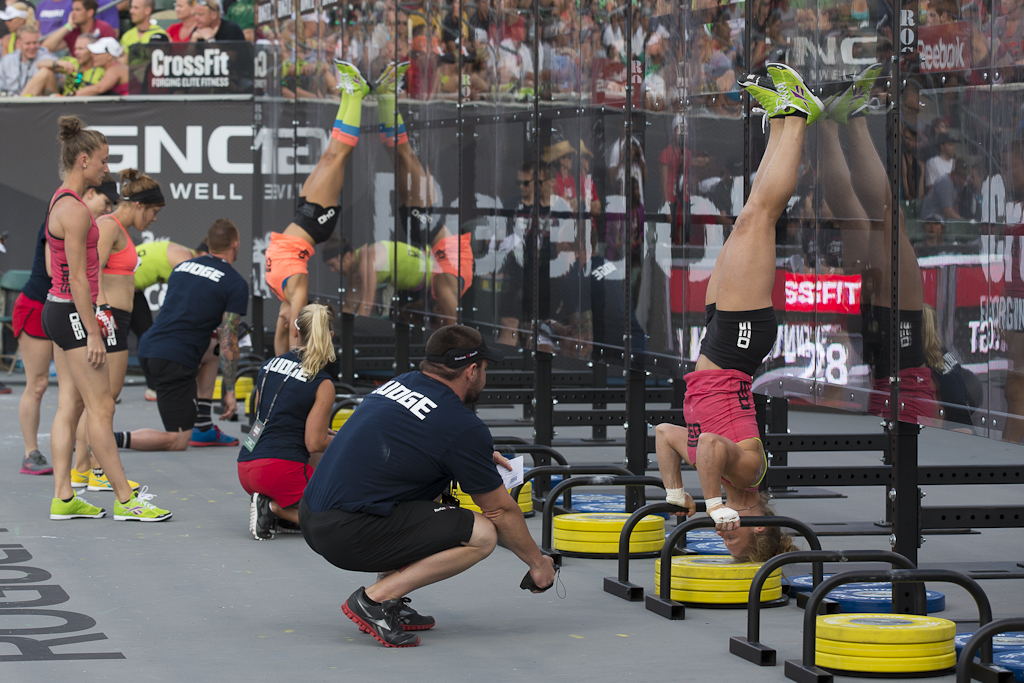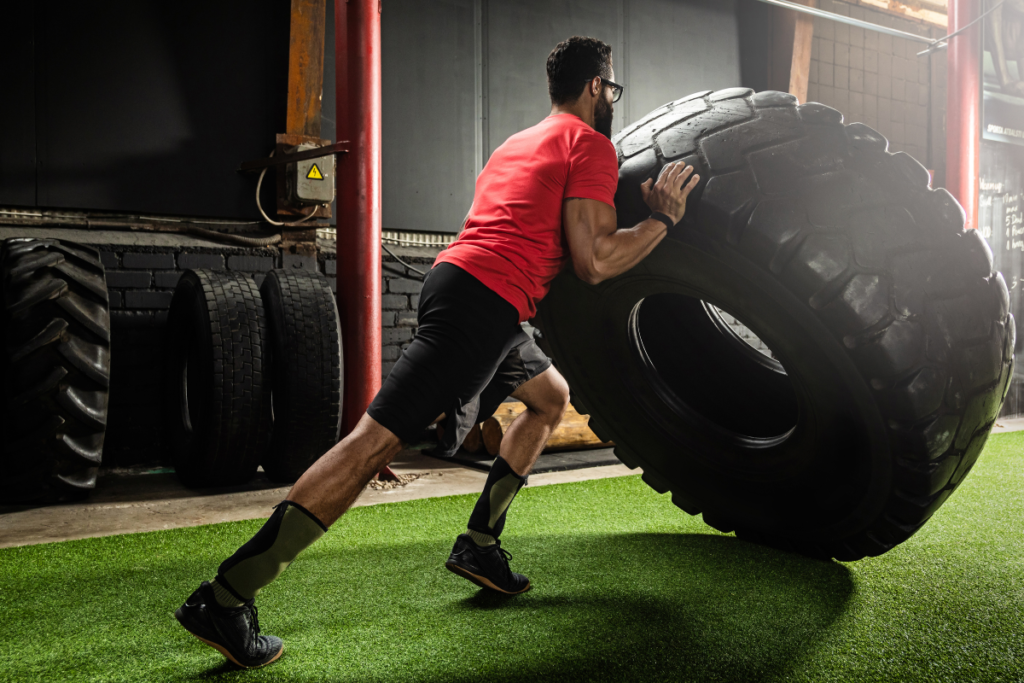Last Updated on September 14, 2023 by Heather Hart, ACSM EP, CSCS
Spoiler alert: this isn’t going to be another post where a running coach trashes CrossFit.
When an ultra runner comes to us for coaching and they are already enjoying a specific modality of exercise, we do everything in our power to help them keep up with the things they enjoy.
Why? Because life is short, and we as humans are not one dimensional (that’s right friends, there’s more to life than running. Shocking, I know!).
I’m also not here to sing its praises either, because the truth is, for every athlete who can successfully balance CrossFit training with ultrarunning, there’s another who’s 100 mile ultramarathon finish line goals were thwarted by their dedication to their WODs (and please know, this lack of prioritizing goals is not exclusive to CrossFit alone).
Rather, in this post I’m hoping to give you an unbiased view of how CrossFit training can potentially help AND potentially hinder your ultramarathon training, as well as provide some professional tips on how you can successfully balance the two.

What is CrossFit?
CrossFit is a branded method of strength, conditioning, and overall fitness programming that consists of functional and constantly varied movements performed at high intensity. CrossFit was developed by Greg Glassman, and co founded with Lauren Jenai during 2000 in Santa Cruz, California.
CrossFit classes are offered at affiliated gyms, also commonly referred to as “boxes”. As of 2023, there are over 10,000 affiliates worldwide (source).
The CrossFit workouts themselves are typically around an hour, and include a warm-up, a skill development segment, the high-intensity “WOD” (workout of the day), and a cool down.
The goal of CrossFit:
According to Glassman, the aim of CrossFit from the very beginning has been to “forge a broad, general, and inclusive fitness” (3). This was done by looking at all sport and physical tasks collectively, and determining what physical skills and adaptations would most universally lend themselves to a general performance advantage.
To put it more bluntly, Glassman states: “our specialty is not specializing”
(Remember that statement for later.)
These goals are met through using a wide variety of equipment, such as (but not limited to):
- traditional weight equipment (barbells, dumbbells, kettlebells)
- gymnastics equipment (rings, rope climbs, pull-up bars)
- plyometrics equipment (plyo boxes, medicine balls, jump ropes)
- cardio equipment such as rowing machines and ski-ergs
…and more.
Programming and methodology is drawn from training disciplines such as Olympic-style weightlifting, powerlifting, and even Strongman events.

Is CrossFit Safe for Runners?
There’s no denying that CrossFit has a reputation for being dangerous, and therefore is looked down upon in many other sport or fitness communities. Indeed, CrossFit has resulted in injures for many individuals. However, in my professional opinion this is not inherently CrossFit’s fault, but rather is more likely due to factors such as:
- Lack of individualized programming: what works for one athlete may be “too much” for another, resulting in an overuse injury. This is not inherent to CrossFit, but a common issue with group exercise (such as bootcamps) in general.
- Skill development: many athletes may dive into workouts involving more complex movements that are above their current skill level, or may not have received proper instruction for specific skills. The nature of group exercise means a coach/instructor cannot have their eyes on every individual at all times. It is important for individuals to know their limitations.
- Recovery: lack of focus on appropriate recovery by the individual, including nutrition, sleep, balancing work or other stressors, may result in injury or burnout. Again, this is not CrossFits fault.
- Peer Pressure: CrossFit is notorious for a “cult like” following where individuals will push each other to complete workouts at all costs – even if that results in injury. But I will argue that the same thing happens in other sports as well (such as encouraging someone to race a 100 miler even though they didn’t train for it.)
- Poor coaching: lastly, not every coach at a CrossFit box is going to truly understand the nuances of exercise science, programming, biomechanics, etc. – despite a credential – and may program or suggest things that result in injury. But this is not a CrossFit only problem – it happens frequently across the widely UN-regulated fitness industry.
Point being, CrossFit comes with risks, but so do most things we do in life. When executed properly, CrossFit can indeed be safe AND beneficial for runners. We’ll talk more about how to achieve this later in the post.
What are the Benefits of CrossFit for Runners?
If you’ve read any of the articles of I’ve written before, you know that I am a huge advocate of runners complimenting their running with strength training. CrossFit, as a mode of exercise, comes with a number of possible benefits.
1. Improved Health
Regular cardiovascular and strength training can help prevent, manage, and treat a number of health conditions from arthritis, cancer, cardiovascular disease, mental health, metabolic issues, pulmonary disorders, and so much more.
This is why every major health organization on this planet recommends that all healthy adults engage in a minimum of 150 minutes of moderate intensity cardiovascular exercise per week, as well as engage in strength training at least 2-3 times per week.
2. Injury Prevention
Regular strength training has been shown to aid in both acute and chronic injury prevention through:
- Increased bone density & strength
- Strengthening muscles & tendons to better facilitate the absorption of ground reaction forces.
- Decreasing muscular imbalances
- Improved coordination, enhanced technique, & better psychological perception of high-risk situations (2).

3. Force Development
Explosive and powerful strength training and plyometric movements – common in CrossFit workouts – may result in a faster rate and capacity for force development (or how effectively you can push against the ground/road/trail when running).
4. Improved Running Economy
Strength training has been shown to help improve running economy – or the amount of oxygen (and thus, energy) required to maintain a specific pace.
It is important to note, however, that increasing running volume is more effective at improving running economy than strength training alone (the principle of specificity).
5. Become a Well Rounded Athlete
As mentioned earlier in this post, the majority of us may have interests outside of running, even if it’s simply “being healthy and strong enough to chase my kids and carry my groceries inside in one single trip”.
The constantly varying nature of CrossFit workouts means you will be challenged to become a more well rounded athlete, strengthening different muscle groups and improving mobility and balance in ways that running alone cannot.
6. It’s Fun
Ultrarunners absolutely love to run – you kind of have to in order to willingly train for and run distances of 50, 60, 100 miles or more. But even the best of us can mentally and emotionally burn out on only running all of the time.
CrossFit will challenge you to move your body in different ways than running, which can sometimes be a welcome reprieve from the montontony of running.
Further, CrossFit typically has a tight-knit community feel, which can have a positive impact on mental health, and give you some much needed identity outside of running.

What are the Cons of Crossfit for Runners?
Of course, not much in life comes without risks, and CrossFit is no exception. But how, specifically, might CrossFit negatively impact your ultra training?
Lack of Specificity
The Principle of Specificity states that physiological adaptations in response to training are highly specific to the mode, intensity, and duration of the training activity. In other words: the best way to get better at running (or to successfully train for a running goal) is to run.
Substituting CrossFit for running specific workouts (when training for a running goal) can hinder running progress. A careful balance must be maintained to ensure run specific training is prioritized (if an ultramarathon is your current goal).
Risk of Injury
As mentioned earlier, CrossFit in and of itself is no more dangerous than most other modes of exercise…but it still comes with a risk of injury. Injuries during CrossFit may stem from improper form, inappropriate loading, or programming (non-functional overreaching).
Decreased Energy Availability
CrossFit workouts are intense by design. Training for an ultramarathon typically involves a high volume of run training. Combine these together, and you are looking at a high level of stress being placed upon your body, that is going to require a lot of energy for both the workouts AND recovery.
If not addressed with adequate nutrition, rest, and recovery, this decreased energy availability may affect the quality of your training runs and the adaptation to your workouts.
Delayed Onset Muscle Soreness
Delayed Onset Muscle Soreness (or “DOMS”) is the sore, tight, painful feeling that many people experience 12-48 hours after a heavy or high intensity workout.
The high intensity workouts and heavy lifts associated with CrossFit workouts may leave an ultra runner experiencing DOMS, that could have an effect on the quality of subsequent training runs.
Time Availability
Training for an ultramarathon is time consuming. Adding CrossFit on top of it adds to an already busy schedule…and sometimes, something has got to give. But sacrificing other training interventions that may be immediately more beneficial to the ultrarunning goal due to time constraints (such as sleep or recovery periods) can possibly hinder your ultrarunning goals.

7 Tips for Balancing CrossFit and Ultra Running
Whether you already love CrossFit, or even if you’re just getting started, you don’t have to sacrifice CrossFit in order to achieve ultrarunning goals. You just have to be smart about your training. Keep these seven tips in mind to help you successfully balance crossfit and ultrarunning.
1. Prioritize Your Goal
You’ve likely heard the term “Jack of all trades, master of none” before -it applies to sport as well. When participating in multiple sport disciplines at once, you’re likely to become “pretty okay” at all of them, but not nearly as proficient as you would be if you were to focus on one discipline.
Keeping that in mind will help you set realistic expectations in both your CrossFit and your running progress. If ultrarunning is your current goal, then know that you likely won’t be improving as quickly or throwing up as heavy weights as those who may prioritize CrossFit as their goal (and this is perfectly acceptable!).
2. Find a Box/Affiliate that Supports YOUR Goal
Just like many ultrarunners have a hard time understanding why you could possibly want to do anything OTHER than spend all of your free time running on trails, you may experience that some CrossFit communities have a hard time understanding why you would want to focus on ultrarunning goals.
It’s important that you find a CrossFit box and coaches that are supportive of your ultrarunning goals, who will be understanding if you want to scale back on workouts during peak ultra training, or skip certain WODs because they may hinder your big picture goal.
3. Check Your Ego – Ask for Help
A major key to avoiding injury in the CrossFit world is ensuring you are using proper form with all movements.
- Ask for help in checking your form, especially with new-to-you movements or exercises.
- Do not be afraid to back down on the weight you are lifting, or to modify exercises, until you are comfortable and confident with your form.

4. Keep Easy Days Easy
Keep the overall structure of your ultramarathon training in mind when incorporating CrossFit. A rest day or recovery day on your running schedule should coincide with a rest day or recovery day in your CrossFit schedule.
Or more simply put: keep hard days hard, and easy days easy, across all disciplines.
This includes both your pre-race taper phase, as well as your post ultramarathon recovery. The focus in both of those phases of training should be on letting your body rest and recover – they are not an appropriate time to double down on CrossFit.
5. As Running Volume Increases, CrossFit Volume Decreases
During your “off season” from ultrarunning, or during the early stages of a training cycle when your running volume is low, you may find it easier to log multiple CrossFit WOD’s in a single week.
However, as your running volume increases, you’ll want to slowly back off on CrossFit volume in order to not hinder your ultrarunning progress.
6. Focus on Fueling & Recovery
As mentioned earlier, both CrossFit and ultramarathon are highly demanding sports – one in intensity, and the other in sheer volume. By combining the two, you are putting excess stress on your body, and in return, your body is going to need extra fuel and recovery time.
- Ensure you are eating enough to sustain both your workouts and recovery. If you’re unsure about this, consult with a registered dietician that specializes in endurance athletes.
- Ensure that you are getting enough sleep every night – a large majority of your recovery happens while you sleep.
- Try to balance other stressors in your life, and have the discipline to pull back in any given area when you feel like you might be doing too much.
7. Listen to YOUR Body
And finally, listen to your body. I know that sounds both cliche and vague, so let me expand:
No two athletes will ever respond to training the same. Just because one athlete can successfully balance multiple CrossFit workouts with ultramarathon training doesn’t mean your body will respond as well.
And on the other hand, just because one ultra runner cannot balance CrossFit and training for an ultra, doesn’t mean that you can’t do it successfully.
Resources:
- Bahr R, Krosshaug T. Understanding injury mechanisms: a key component of preventing injuries in sport. British Journal of Sports Medicine 2005;39:324-329.
- Blagrove, R. C., Howatson, G., & Hayes, P. R. (2018). Effects of Strength Training on the Physiological Determinants of Middle- and Long-Distance Running Performance: A Systematic Review. Sports medicine (Auckland, N.Z.), 48(5), 1117–1149
- Glassman, Greg. “Understanding CrossFit” (PDF). The CrossFit Journal.
Heather Hart is an ACSM certified Exercise Physiologist, NSCA Certified Strength and Conditioning Specialist (CSCS), UESCA certified Ultrarunning Coach, RRCA certified Running Coach, co-founder of Hart Strength and Endurance Coaching, and creator of this site, Relentless Forward Commotion. She is a mom of two teen boys, and has been running and racing distances of 5K to 100+ miles for over a decade. Heather has been writing and encouraging others to find a love for fitness and movement since 2009.

Leave a Reply